Struggling to keep up with credit card bills? You’re not alone. In the first quarter of 2025 alone, 1.4 million Canadians missed at least one credit payment.
If your credit card debt is so high that you can’t even make the minimum payments, it’s time to look at debt relief options. One route is credit card debt forgiveness, where you negotiate to pay less than you owe, with the rest written off.
It’s not a quick fix or available to everyone. Your credit score may take a hit, and new credit could be harder to get for a while, but you can eliminate a portion of your debts and make a fresh start.
In this article, we’ll look at the main credit card debt forgiveness programs in Canada and weigh the pros and cons, so you can decide what’s right for you.
Contents
What is debt forgiveness?
Debt forgiveness is when your creditors agree to wipe out all or part of what you owe, usually through a formal debt relief program when you can’t afford to repay.
In Canada, most unsecured debts like loans, credit cards, lines of credit, overdrafts and debts in collections can be forgiven, and in certain cases, even student loans or CRA debts.
There are specific rules about who qualifies and which debts can be included. Let’s take a closer look at how debt forgiveness works and what your options might be.
Is there a Canadian credit card debt forgiveness program?
No government program simply wipes out credit card debt, but real debt forgiveness is possible with a consumer proposal or bankruptcy.
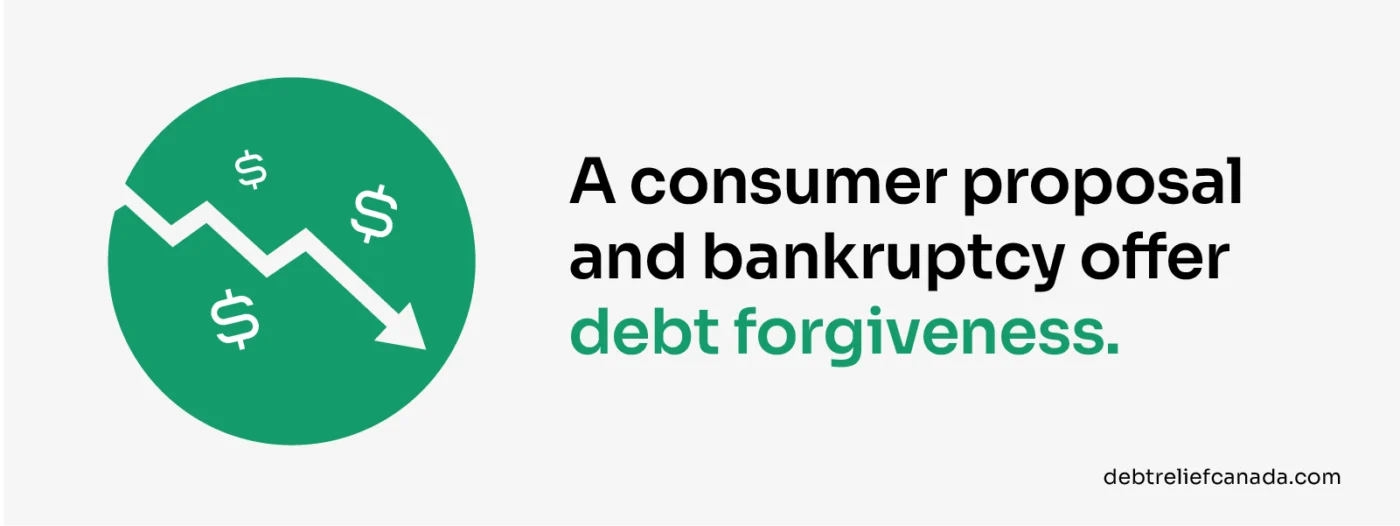
Both options are legally binding, regulated by the Canadian government, and can only be arranged through a Licensed Insolvency Trustee.
After completing either process, all your remaining unsecured debts are written off, and you’re no longer required to repay them.
A consumer proposal is the most popular government legislated debt relief program, letting you reduce your debt by up to 80% without declaring bankruptcy.
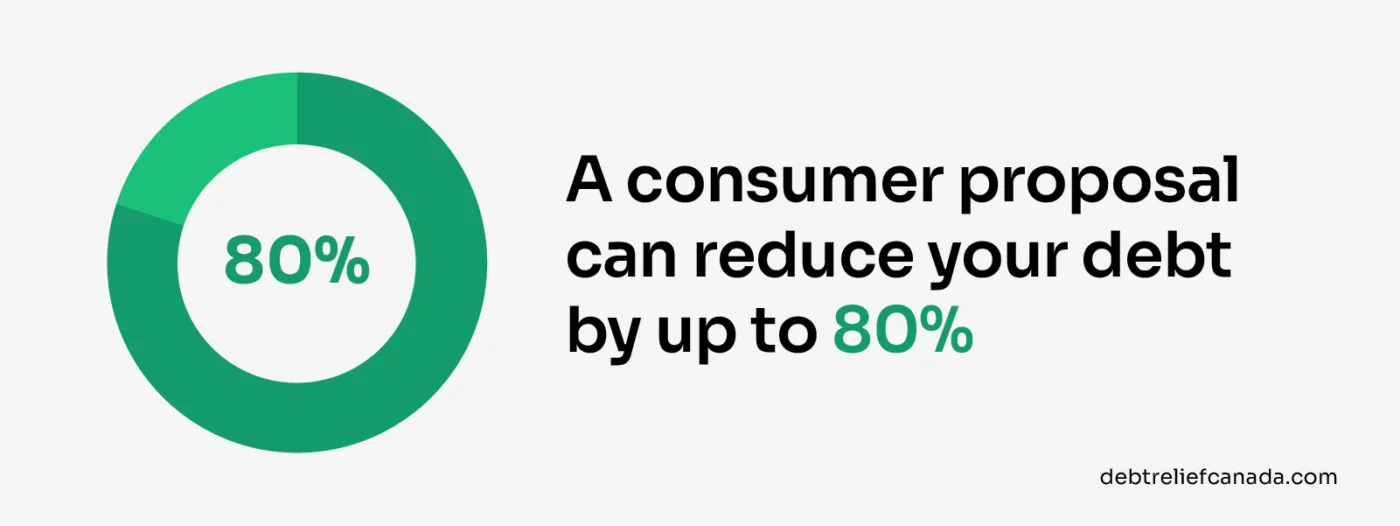
Only a Licensed Insolvency Trustee can offer debt forgiveness, legal protection from collection calls, and wage garnishments. Be wary of companies promising government debt forgiveness or quick fixes—many are scams.
If you’re struggling to make payments, get free advice from a Licensed Insolvency Trustee to see which options you qualify for and avoid costly mistakes.
Other options like debt management plans, debt settlement and debt consolidation can help you manage your debt, but they won’t forgive a portion of the debt.
Government legislated credit card debt forgiveness programs
In Canada, the only real way to eliminate credit card debt for less than what you owe is through a consumer proposal or bankruptcy.
Consumer Proposal
A consumer proposal is Canada’s top choice for formal debt relief. It’s popular because you can slash what you owe—sometimes by up to 80%—and you don’t have to go bankrupt to do it.
It’s a formal agreement, managed by a Licensed Insolvency Trustee, where you repay part of your debt over a period of up to five years.
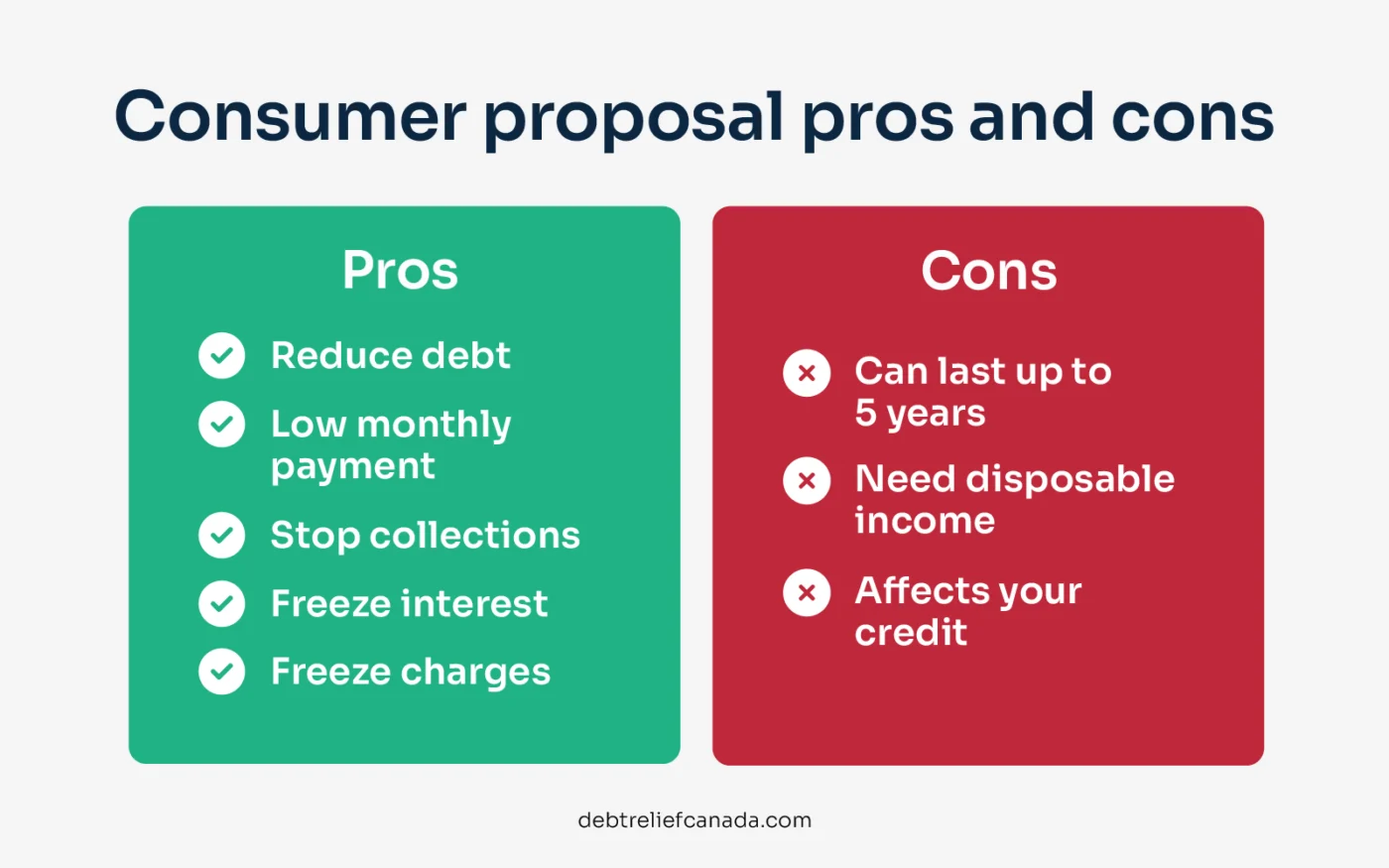
It’s legally binding and lets you keep your assets while making one affordable monthly payment. If most creditors accept your offer, you’re protected from collection calls and legal action. Once your payments are complete, the rest of your debt is wiped out.
Consumer proposals cover most unsecured debts, including credit cards, personal loans, lines of credit, payday loans and old bills.
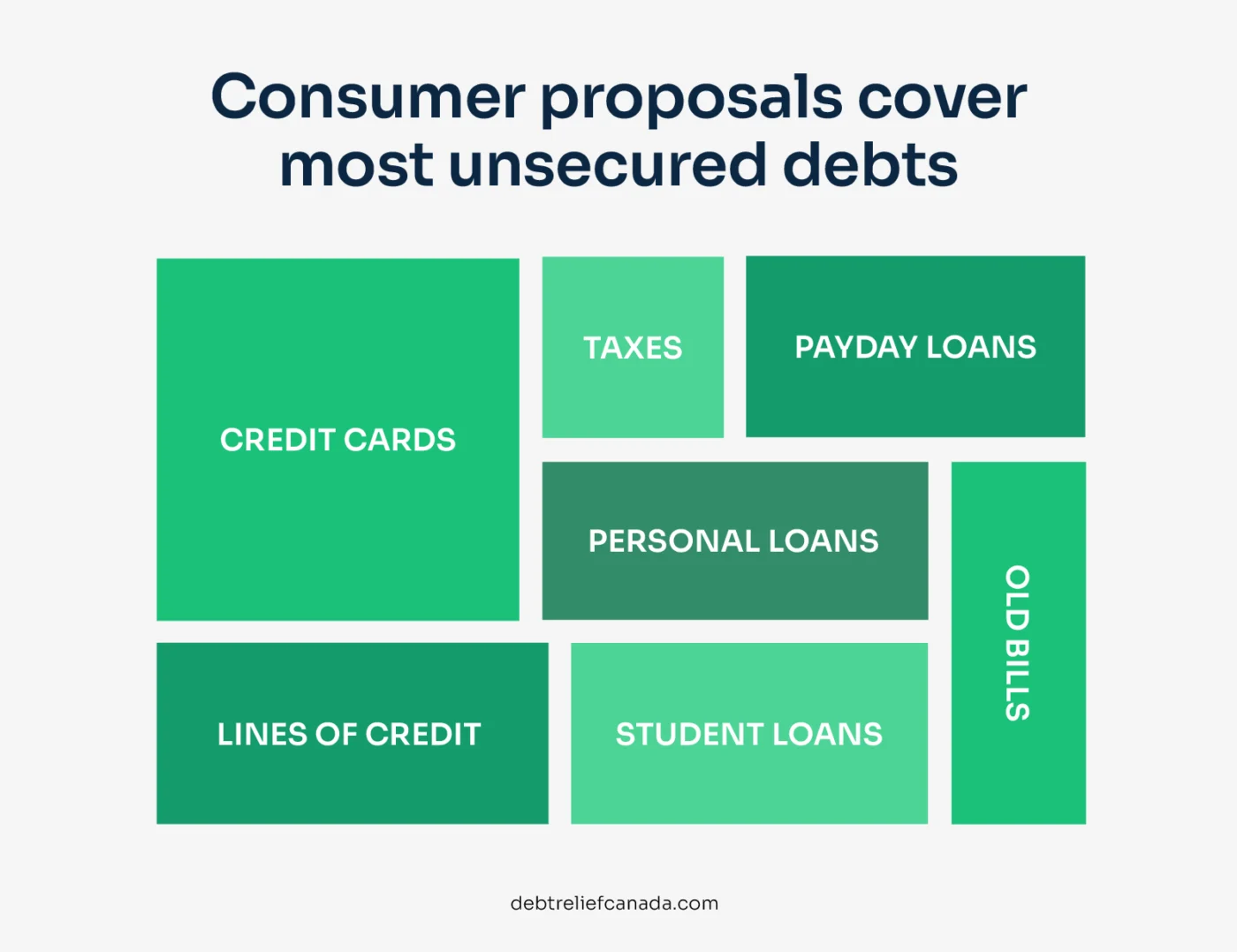
CRA tax debts can be included under certain circumstances, and so can student loans if it’s been at least seven years since you finished your studies. Secured debts, like mortgages and car loans, aren’t included.
How much you pay in a proposal depends on what you can realistically afford. It’s based on your total debt, what creditors are likely to recover, your income and any assets you have.
A Licensed Insolvency Trustee’s fees and costs are deducted from your monthly payments, so you won’t pay anything extra on top of what you’ve agreed to.
What are the benefits?
- Legal protection from creditors
- Collection calls and wage garnishments stop immediately when you file
- You keep your assets, including your home and car, in most cases
- One fixed, interest-free monthly payment
What are the drawbacks?
- Like most debt solutions, a consumer proposal will lower your credit score; it appears on your credit report for at least three years after completion
- You must stick to the payment plan; missed payments can cancel the proposal
- Not all debts are eligible
Bankruptcy
Bankruptcy is a legal process that lets you erase most debts if you have no realistic way to repay them. It’s usually the last resort, but it’s effective and fast.
It is a practical solution for unmanageable debt caused by financial hardship as a result of job loss, illness, divorce or unexpected expenses.
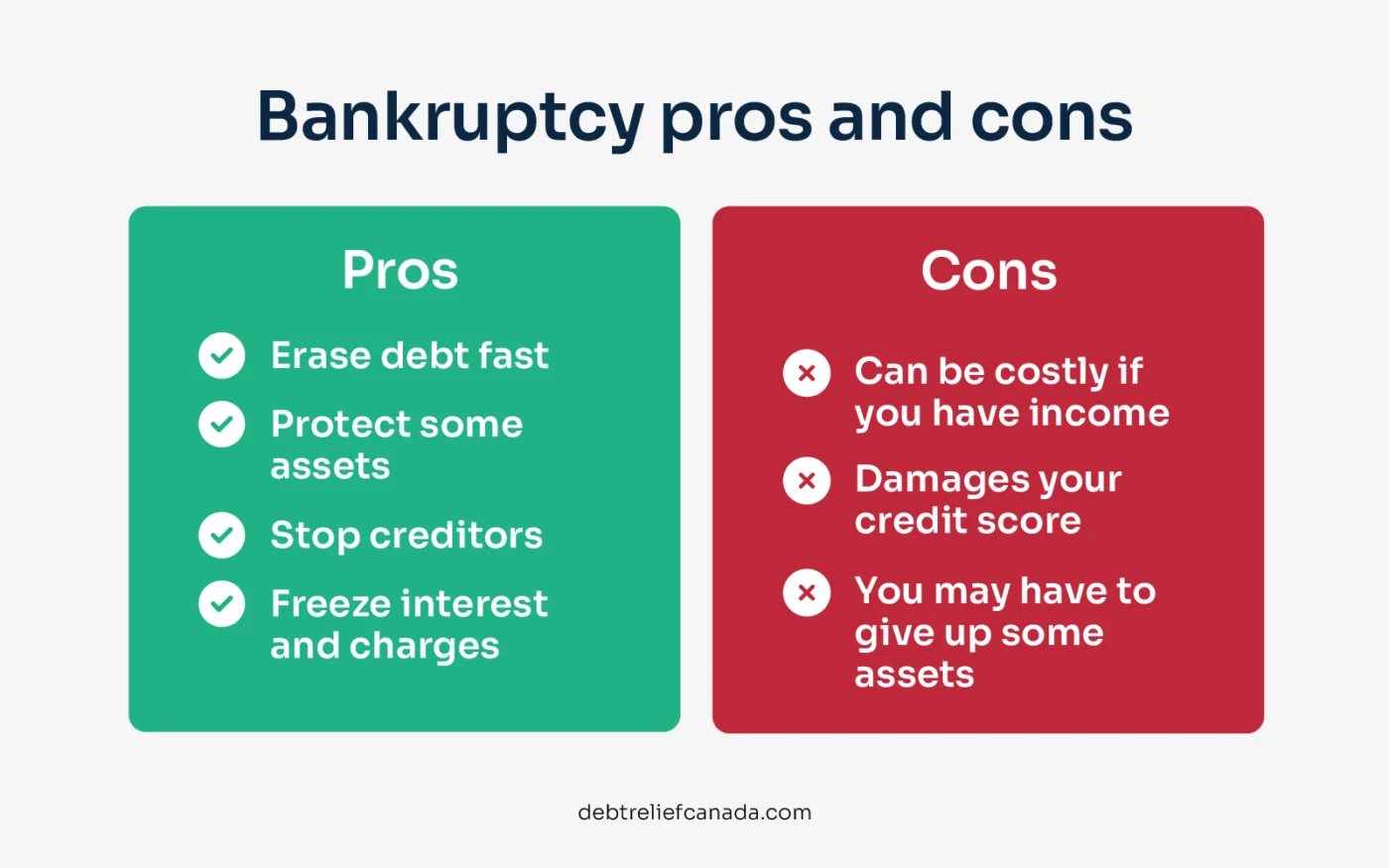
You may have to give up some assets, and your credit score will take a hit, but once the process is complete, all your debts will be wiped out, and you can start rebuilding your credit.
Some assets might be sold to repay creditors, but essential property is protected by exemptions.
It’s a formal process managed by a Licensed Insolvency Trustee and usually takes between 9 and 21 months to complete.
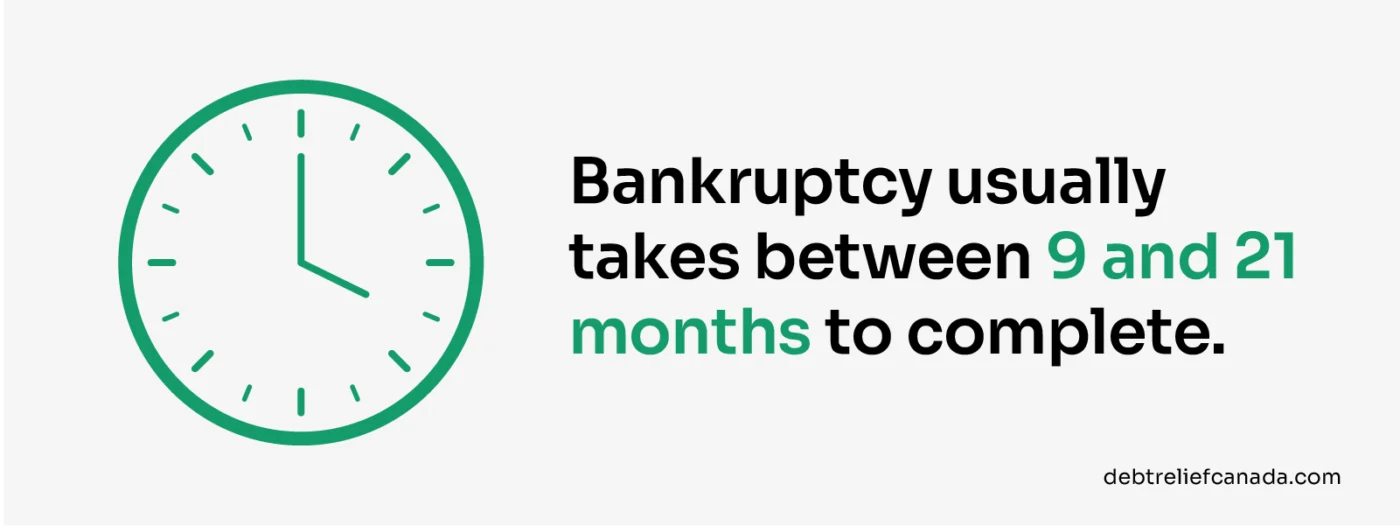
Like a consumer proposal, most debts, including credit cards, lines of credit and payday loans, can be eliminated. Some student loans and tax debts can also be included.
Secured debts, child support, alimony, court fines, and recent student loans usually can’t be forgiven.
What are the benefits?
- Most debts are wiped out in as little as nine months
- Collection calls and legal action stop immediately
- All interest and charges are frozen when you file
- Wage garnishments are lifted
- It can be less expensive if you have few assets and a low income
What are the drawbacks?
- Your credit score takes a major hit, and bankruptcy stays on your credit report for at least six years after completion
- You may have to give up some assets, though basic property is protected
- There is a public record of your bankruptcy proceedings
Other debt relief options (not debt forgiveness)
While only a consumer proposal or bankruptcy can write off credit card debt in Canada, some debt relief options make your payments more manageable and give you a better chance to clear your debt.
Debt management plan
A debt management plan, set up through a non-profit credit counselling agency, rolls your debts into one monthly payment and usually cuts your interest rate, sometimes down to zero.
You get support from a counsellor and an easier way to manage your payments, but you still have to repay the full amount.
No debt is forgiven, though interest relief can help you save money.
Your credit score will likely drop during a debt management program, but paying off your debts will help your credit recover over time.
Debt settlement
Debt settlement is when you negotiate with creditors (e.g. your credit card issuer) to settle your debt for less than the full amount, usually by offering a lump-sum payment.
You can try to do this yourself, but credit card companies may only be willing to negotiate if you’re far behind on payments and they believe you’re unlikely to repay the full balance.
If you go DIY, call your creditors, offer a lump sum, and get written confirmation of the agreed debt repayment plan before sending any money.
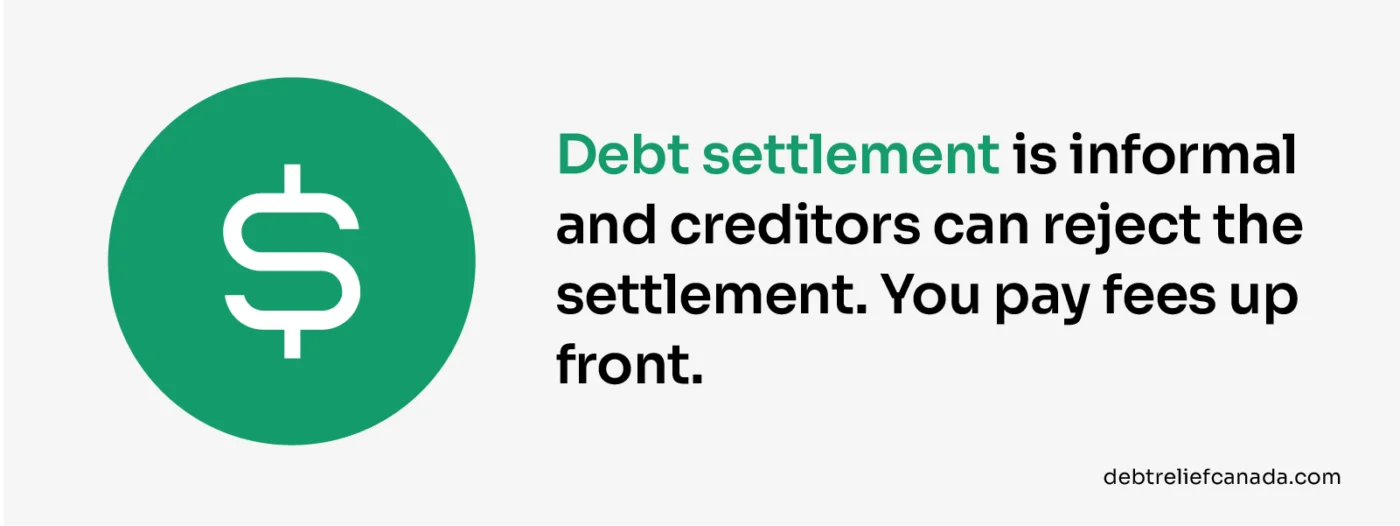
Be wary of settlement companies. Creditors aren’t required to negotiate with them, and there’s no guarantee of debt forgiveness. Many companies also charge high upfront fees.
Credit card debt settlement is risky. Creditors can still sue you or garnish your wages until a deal is reached. Your credit score can drop if you miss payments during debt settlement negotiations.
Scams are common. Avoid debt settlement companies asking for money up front or promising to erase your debt quickly.
Debt consolidation
A debt consolidation loan rolls your debts into one monthly payment, often at a lower interest rate. It won’t wipe out what you owe, but it can make payments more manageable if you have a steady income and good credit.
This approach is useful if you’ve got credit card balances, payday loans or other debts piling up. By consolidating, you can cut down on interest and make life simpler with a single payment.
Consolidating debt can be done in many ways, including through a consolidation loan, a line of credit or a balance transfer card.
The catch? You still have to repay the full amount, and you’ll need a decent credit score to qualify. If you miss payments, you could end up worse than before.
Debt consolidation isn’t forgiveness, but it’s a practical way to get control if you’re still able to meet your payments. It can be an effective form of credit card debt relief.
Orderly payment of debts
If you live in Alberta or Nova Scotia, you may qualify for the Orderly Payment of Debts (OPD) program.
This lets you pay off your unsecured debts over five years at a fixed 5% interest rate while keeping your assets.
Creditors and the court must approve the plan. To see if OPD is right for you, contact your provincial OPD agency.
Comparing credit card debt relief options
| Solution | Forgives debt? | Stops collections? | Impacts credit? | Keep assets? | Provider |
|---|---|---|---|---|---|
| Consumer Proposal | Yes | Yes | Yes | Usually | Licensed Insolvency Trustee |
| Bankruptcy | Yes | Yes | Yes | Maybe not | Licensed Insolvency Trustee |
| Debt management plan | No | Sometimes | Yes | Yes | Non-profit Credit Counsellor |
| Debt settlement | Maybe | No (until settled) | Yes | Yes | Private company or on your own |
| Debt consolidation loan | No | No | No | Yes | Lender or bank |
How to get credit card debt forgiven
Being in debt is an awful place to be, but credit card debt forgiveness solutions are available to give you breathing room and help you get back on track.
If you’re in trouble, speak to a Licensed Insolvency Trustee for real advice and protection under Canadian law. It’s free, confidential and could change your life.


